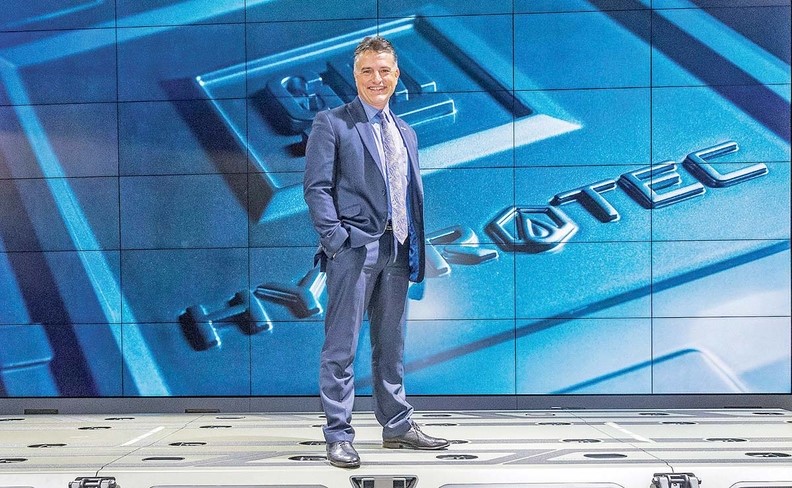“I am very optimistic about the outcome,” says GM’s executive director of HYDROTEC, Charles Freese. Together with Nel’s Vice President for Research and Development, Kathy Ayers, he is leading the collaboration to further improve Nel’s technology.

Prior to the R&D partnership, Ayers sat on the Hydrogen and Fuel Cells Technical Advisory Committee (HTAC) for the US Department of Energy together with Charles Freese, GM executive director, Global HYDROTEC. HTAC was providing technical and programmatic advice to the Energy Secretary on DOE’s hydrogen research, development, and demonstration efforts.
Now the two technology leaders have gathered some of their most talented people on each side into a joint team that endeavors to make Nel’s PEM electrolysers even more efficient and cost-effective.
"Entering this joint venture development with GM is more productive and highly inspiring for everyone."
Kathy Ayers, Vice President for Research and Development Nel Hydrogen
“Before our formal collaboration, there were informal connections between professionals working in the same field. However, entering this joint development with GM is more productive and highly inspiring for everyone,” says Ayers.
GM is a global leader in fuel cell technology, and Nel has deep expertise in renewable hydrogen production. Moreover, the two companies are mutually interested in lowering the costs of renewable hydrogen below fossil sources.

“The collaboration aims to get us more hydrogen out of every unit of electricity and every cent,” says Kathy Ayers, Vice President, Research and Innovation at Nel.
Proton Exchange Membrane (PEM) electrolysers and fuel cells are very similar technologies. The PEM electrolyser uses water and electricity to produce hydrogen. The fuel cell generates electricity from hydrogen and oxygen, emitting water.
“The PEM technology is particularly suited for heavy-duty applications using fuel cells. To get zero-emission trucks, trains, auxiliary aircraft power, renewable energy systems and more, it all comes down to the price of a hydrogen molecule,” says Freese.
The collaboration, which aims to develop technology enabling cost-competitive hydrogen production from renewable energy, was signed in November 2022, and kicked off with all team members assigned January 2023.
“The idea is to reuse our companies’ technology investments in fuel cells and electrolysers. Regarding innovation, it usually works to gather experts on known technologies, representing slightly different perspectives. We have started to explore the design space and opportunities. I’m very optimistic about the outcome,” says Freese.
"We have started to explore the design space and opportunities. I’m very optimistic about the outcome."
Charles Freese, Executive Director of HYDROTEC, General Motors
Ayers tells about the significant advantages of gaining access to GM’s development tools and computing powers. All collaborating engineers can test and build upon each other’s ideas and knowledge.
“I feel that our cultures have much in common, with heavily invested people and no big egos. The collaboration allows us to work in complete confidence and openness in a sharing environment. We are learning and developing so much faster by teaming up,” says Ayers.
Through the collaboration, Nel can simulate new designs much more precisely, before making prototypes. As a result, advanced, rapid modeling accelerates development while reducing risks and costs.
“To help unlock the potential for hydrogen produced from renewable energy we are designing the system and the manufacturing process together”, says Freese.
Until now assembly of PEM electrolysers has been dependent on manual work, with its natural limitations when it comes to volumes and speed. However, GM has vast experience in designing efficient manufacturing.
“We approach the challenge from two perspectives; the first is optimizing the technologies themselves, which goes for both PEM electrolysers and fuel cells. The second is automating the manufacturing process. The key to getting the costs down is scaling up,” says Ayers.
Nel is planning to automate the manufacturing of PEM electrolysers, as has already been accomplished with alkaline electrolysers at the Herøya factory in Norway.
“The fact that Nel has chosen Michigan as the location for their upcoming gigawatt facility is highly beneficial for building the renewable industry. We are headquartered in Detroit, the heartland of the American car industry. What we achieve here will impact multiple industries,” says Freese.
Ayers notes that on Nel’s side, the ability to scale up and speed up manufacturing will also be a game-changer within the world’s chemical industry. Hydrogen is widely used for industrial purposes, and Nel has been in the business since 1927.
“Unfortunately, 96% of the hydrogen used today is carbon-based, which still emits CO2 emissions, unless accompanied by carbon capture technology.” Ayers explains that fossil hydrogen is still cheaper to produce, but the overall costs are too high for the global community.
The ratio between CO2 and hydrogen derived from natural gas is about 8:1, meaning that for 1 kg of hydrogen, 8 kg of carbon dioxide will be produced. However, electrolysis offers a method to extract energy with a lower carbon profile from the grid, when grid demand fails to match available wind or solar electricity production. Hydrogen can become a viable solution for storing energy over extended periods of time. The stored hydrogen serves as an important energy source for the largest vehicles that move heavy payloads over long distances, requiring fast refueling.
"We are becoming capable of producing hydrogen from renewable energy at a very large scale, at prices fossils will have a hard time matching."
Kathy Ayers, Vice President for Research and Development Nel Hydrogen
“Policymakers worldwide are stepping up CO2 taxes, regulations, and funding to diversify the energy economy and enable renewable solutions. At the same time, we are becoming capable of producing hydrogen from renewable energy at a very large scale, at prices fossils will have a hard time matching,” says Ayers.
Freese points out that the fossil fuel industry historically has had little competition, but that is about to change.
“The trend for renewable hydrogen is positive. Together we develop technology that helps make hydrogen more affordable. I predict we will have more affordable, efficient, flexible renewable solutions quite soon to fit many new applications,” says Freese.
Cover photo by Steve Fecht for General Motors.